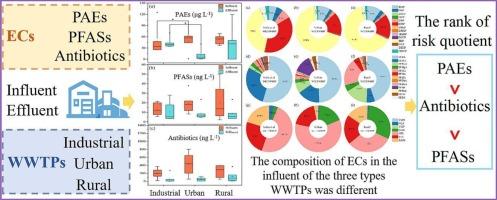中国陕西省工业、城市和农村污水处理厂中 PAEs、PFASs 和抗生素的发生、归宿和生态风险
IF 6.3
2区 工程技术
Q1 ENGINEERING, CHEMICAL
引用次数: 0
摘要
废水处理厂(WWTPs)被认为是从人类活动作为新污染物(ECs)的源到水生生态系统作为新污染物(ECs)的汇的转运枢纽。本研究调查了邻苯二甲酸酯(PAEs)、全氟烷基和多氟烷基物质(PFASs)以及抗生素在陕西省工业、城市和农村污水处理厂进水和出水中的去向。在工业、城市和农村污水处理厂中,这三种ECs的第一大单体含量相同。城市和农村污水处理厂进水中 PAEs 的组成与工业污水处理厂有很大不同。城市污水处理厂对 PAEs 和 PFASs 的去除率高于农村和工业污水处理厂。农村污水处理厂的 PFASs 年质量负荷低于工业和城市污水处理厂。PAEs 的风险商数较高,大部分超过 1。而 PFAS 的风险商数较低,只有部分工业污水处理厂的风险商数超过 0.1。城市和农村污水处理厂总抗生素的高风险频率高于工业污水处理厂。这项研究提供了实地调查数据,并为加强该地区的氨基甲酸乙酯管理提供了指导。本文章由计算机程序翻译,如有差异,请以英文原文为准。

Occurrence, fate, and ecological risk of PAEs, PFASs, antibiotics in industrial, urban and rural WWTPs in Shaanxi Province, China
The wastewater treatment plants (WWTPs) were considered as a hub of transit from human activities as a source to the aquatic ecosystems as a sink of emerging contaminants (ECs). This study investigated the fate of phthalate esters (PAEs), per- and polyfluoroalkyl substances (PFASs) and antibiotics in the influent and effluent of WWTPs in industrial, urban and rural in Shaanxi province (China). The first most abundant monomer of these three types of ECs were the same in industrial, urban and rural WWTPs. The composition of PAEs in the influent of urban and rural WWTPs were quite different from that of industrial WWTPs. The removal efficiency of PAEs and PFASs in urban WWTPs were higher than those in rural and industrial WWTPs. The annual mass load of PFASs in rural WWTPs was lower than that in industrial and urban WWTPs. The risk quotient (RQ) of PAEs was high, with most of them exceeding 1. While the RQ of PFASs was low, exceeding 0.1 only in some industrial WWTPs. The frequency of high risk of total antibiotics in urban and rural WWTPs was higher than that in industrial WWTPs. This study provided field survey data and guidance to strengthen the management of ECs in the region.
求助全文
通过发布文献求助,成功后即可免费获取论文全文。
去求助
来源期刊

Journal of water process engineering
Biochemistry, Genetics and Molecular Biology-Biotechnology
CiteScore
10.70
自引率
8.60%
发文量
846
审稿时长
24 days
期刊介绍:
The Journal of Water Process Engineering aims to publish refereed, high-quality research papers with significant novelty and impact in all areas of the engineering of water and wastewater processing . Papers on advanced and novel treatment processes and technologies are particularly welcome. The Journal considers papers in areas such as nanotechnology and biotechnology applications in water, novel oxidation and separation processes, membrane processes (except those for desalination) , catalytic processes for the removal of water contaminants, sustainable processes, water reuse and recycling, water use and wastewater minimization, integrated/hybrid technology, process modeling of water treatment and novel treatment processes. Submissions on the subject of adsorbents, including standard measurements of adsorption kinetics and equilibrium will only be considered if there is a genuine case for novelty and contribution, for example highly novel, sustainable adsorbents and their use: papers on activated carbon-type materials derived from natural matter, or surfactant-modified clays and related minerals, would not fulfil this criterion. The Journal particularly welcomes contributions involving environmentally, economically and socially sustainable technology for water treatment, including those which are energy-efficient, with minimal or no chemical consumption, and capable of water recycling and reuse that minimizes the direct disposal of wastewater to the aquatic environment. Papers that describe novel ideas for solving issues related to water quality and availability are also welcome, as are those that show the transfer of techniques from other disciplines. The Journal will consider papers dealing with processes for various water matrices including drinking water (except desalination), domestic, urban and industrial wastewaters, in addition to their residues. It is expected that the journal will be of particular relevance to chemical and process engineers working in the field. The Journal welcomes Full Text papers, Short Communications, State-of-the-Art Reviews and Letters to Editors and Case Studies
 求助内容:
求助内容: 应助结果提醒方式:
应助结果提醒方式:


